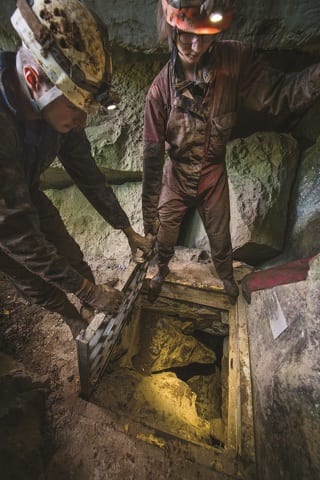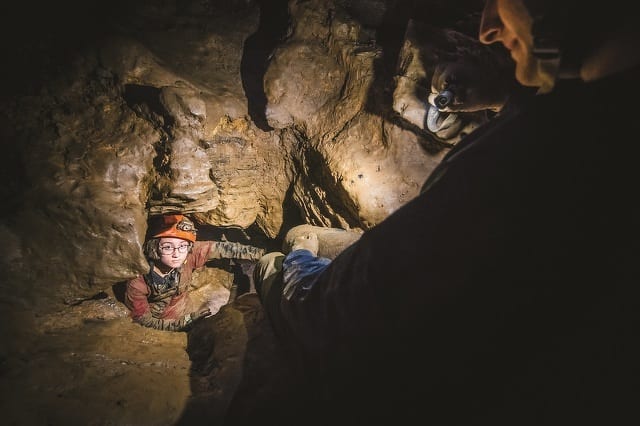Often ranked high on “best of” lists about great places to live in the United States, Centre County boasts some of the best fishing, hiking, kayaking, and more when it comes to outdoor adventures. However, the county and nearby counties are also home to some wonderful natural wonders that are often overlooked – the areas impressive caves and caverns.
Natural cavities that occur beneath the earth’s surface, caves and caverns offer fascinating chambers that are exciting to explore. Full of stalactites and stalagmites, waterways and nighttime creatures like bats, caves offer some spectacular new scenery.
“Caves are works of art and there are conservation communities built around preserving them,” says Hunter Wodzenski, a member of the caving group Nittany Grotto Inc. “A huge part of the sport is a focus on protecting caves as a natural resource.”
Managers of places like Penn’s Cave in Centre Hall and Lincoln Caverns in Huntingdon work hard to maintain the pristineness of their caves, while showing the public the amazing natural sculptures and passageways created millions of years ago. They’re great tourist destinations, especially on hot days because they stay around the same temperature year-round, often around the average annual temperature of the region in which the cave is located. Penn’s Cave, for instance, remains at a constant 52 degrees. Even on the hottest days of the year, visitors are encouraged to bring jackets for their visit.
A tour of Penn’s Cave means riding through the waterway on a boat, while Lincoln Caverns offers a walking tour in which visitors view cave formations like delicate crystals, sparkling stalactites, and massive flowstones. In addition to Penn’s Cave and Lincoln Caverns, Pennsylvania is home to other popular commercial caves such as Indian Echo Caves in Hummelstown and Laurel Caverns in Farmington.
But, for the adventurous folks looking to explore the less-explored, there’s plenty more.
An avid scuba diver, Wodzenski, who lives in Pittsburgh and takes online classes full-time at Penn State, says caving was at the top of his to-do list. He came upon the Nittany Grotto website and reached out to the group in preparation for his next trip to State College. He says exploring with the group was well worth the trip.
Founded in 1948, the State College-based group is one of the oldest chapters of the National Speleological Society. The group’s purpose, according to its website, is to “promote interest in, and advance in any and all ways the study and science of speleology and the protection of caves and their natural environment; and to promote fellowship among those interested therein.”
Six years ago when Abbe Hamilton, a freelance writer, was moving to State College, she reached out to Nittany Grotto.
“I’d been an active caver when I lived in New England and knew that meeting the local cave community would be my fast-track to having local friends. They did not disappoint,” she says. “Nittany Grotto members are constantly caving; there’s something going on nearly every weekend if you’re willing to travel, and usually on a weeknight, too.”
For beginners, Hamilton says the group is very welcoming. Group members try to organize beginner-friendly trips once every two weeks.
“We tell beginners to outfit themselves in clothes that they’re not afraid of ruining – this is a hobby that’s really hard on gear; everything gets muddy and torn – and that they should wear a non-cotton base layer to keep themselves warm in the frequently damp environment,” she says. “We also tell them to wear sturdy shoes – sneakers or rubber boots are ideal. Responsible cavers wear helmets and carry three sources of light apiece: the Grotto has spears for first-timers.”
As a new caver himself, Wodzenski says the group provided him with everything he needed for his first outing.
“I was hooked after my first trip and was quick to gather everything I needed for my next,” he says. “Meeting new people led me to other loose groups and grottos around Pennsylvania, providing endless opportunities for caving.”

Preparing to enter the cave. Photo by Darren Andrew Weimert.
Even though Wodzenski purchased his own tools for caving and lives further away from the home-base of the group, he strongly discourages cavers, especially new ones, from going alone.
“Even though Pennsylvania caves are relatively difficult to get lost in and most of the inherent dangers can be overcome with a little athleticism, caving in groups with an experienced member at the helm ensures that there are few situations that are cause for worry,” he says. “Getting stuck every once in a while is part of the fun.”
Hamilton, who has explored more than 200 caves, says part of the appeal is that each one is different. When she first began, she says the alien feeling of the dark, remote environment both scared and excited her. Now, knowing that there are always new caves for her explore excites her.
“To me, the initial discovery and exploration process is exciting in a way that nothing else has ever been,” she says. “It’s like walking on the moon when I’m the first person to set foot in a newly discovered cave passage.”
Add to that the weird and exciting things she has seen, and it’s a wonder more people do not go caving.
“Nittany Grotto’s Dr. Jenn Macalady’s devoted her career to studying the extremophile bacteria species that grow on cave walls. When I was on an expedition in Mexico this spring, we collected specimens of all kinds of cave-adapted millipedes and other insects we found. It’s fairly common to discover new species if you find them underground,” she says. “I personally have never seen fish in caves, but I know there are some cool cave-adapted ones in other parts of the country. Most of my wildlife encounters in Pennsylvania are with salamanders, frogs, and the occasional bat.”
Hamilton says Nittany Grotto is a great resource for those interested in learning to cave, because members know how to keep cavers safe and keep the caves safe from cavers. To learn more about the group visit caves.org/grotto/nittany/main.htm.
Rebekka Coakley is a freelance writer.



